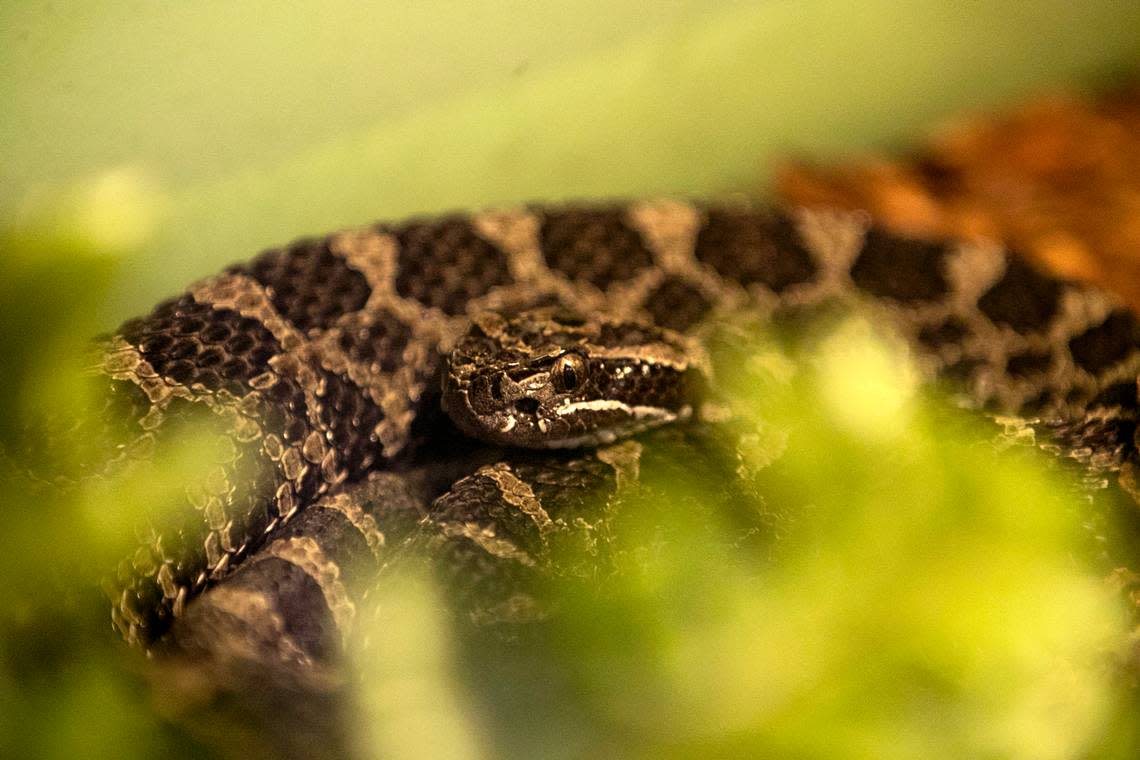Pennsylvania is home to several endangered snakes. Here’s how to spot them this summer

Whether you’re poking around in your backyard or exploring area trails, you’re bound to come across a snake at one point or another this summer.
Nearly all of Pennsylvania’s 21 native species of snakes are harmless, but some are rarer than others. According to Pennsylvania law, three species native to the commonwealth are endangered: the eastern massasauga rattlesnake, Kirtland’s snake and the northern rough greensnake.
If you’re heading outdoors this summer, here’s what you need to know about Pennsylvania’s endangered snakes.
Eastern massasauga rattlesnake
The eastern massasauga rattlesnake (Sistrurus catenatus) is one of three venomous snakes native to Pennsylvania, but it’s also one of the commonwealth’s most threatened species.
These brown-colored snakes can grow up to 3 feet long and are easily identified through their black or brown blotches. Massasaugas have small and quiet rattles, but they are used sparingly, according to Penn State Extension, the university’s science-based information and educational materials agency.
Massasaugas spend their summers in upland forests, but move into wetlands and wet grasslands in the spring, fall and winter, Penn State Extension writes. Losses of usable habitats have threatened the species’ survival as many of the meadows, wetlands and prairies that once served as the snakes’ homes have become human settlements and farmland over the years.
A 2013 survey of the population found these snakes primarily in only Butler and Venango counties in western Pennsylvania, Penn State Extension reports.
These rattlesnakes ambush and kill prey by using their venom to cause internal bleeding. Mature snakes generally eat small rodents, while younger snakes prefer amphibians and invertebrates. Regardless, they are highly unlikely to bite humans if unprovoked.
“Massasaugas are secretive snakes who prefer to hide from people, but when people find massasaugas, they tend to kill these beautiful snakes out of fear, despite there being few instances of massasaugas biting humans,” Penn State Extension writes.
If you stumble across a massasauga or another venomous snake, do not panic. As the National Park Service writes, venomous organisms unload their toxins through only bites and injections, not by touch or direct contact. Poisonous organisms, meanwhile, are toxic when ingested. Though the terms are often used as synonyms, they are notably different.
Pennsylvania is home to 3 types of venomous snakes. Here’s how to spot them
Kirtland’s snake
Kirtland’s snakes (Clonophis kirtlandii) are found across several states, including western Pennsylvania, though the commonwealth’s Fish and Boat Commission considers sightings “very rare.”
The key characteristic for this species is each snake’s bright red, pink or orange belly that is traditionally bordered by two parallel rows of black spots, Michigan State University researchers write. Their heads are often mostly black or dark brown, while the rest of their bodies are usually reddish or dark brown.
These snakes check in on the smaller side, usually topping out between 14 and 25 inches long.
Kirtland’s snakes are usually found in open wetlands, including wet prairies, meadows and marshes, but they may also be found on the edges of forested wetlands and floodplains. The species is nocturnal and fossorial, meaning it burrows underground.
“This snake is highly secretive and, unlike other reptiles, it rarely basks in the sun and generally remains under debris, leaf litter or other cover objects,” Michigan State Extension writes.
This popular Pennsylvania destination was named one of the top ‘secret beaches’ in US
Northern rough greensnake
The northern rough greensnake (Opheodrys aestivus aestivus) marks the last of Pennsylvania’s three endangered snakes.
These snakes grow between 22 and 32 inches, according to the Pennsylvania Fish and Boat Commission. The species also features a long, tapering tail and a distinct uniform light or pale-green color outside of its white or yellowish-green belly. Other distinct features include the snakes’ divided anal plates and sharply keeled scales.
The northern rough greensnake remains one of the mildest species in Pennsylvania, state officials say.
“It is easy to understand why this snake carries the nickname ‘vine snake’ considering its color, slight build and penchant for climbing through brush,” the Pennsylvania Fish and Boat Commission writes. “The rough greensnake is a graceful animal, liquid-like in its movements from one tree branch to another. It is mild-tempered and not easily aroused when confronted.”
These snakes are often found in bushes, vines and low-hanging branches of trees near streams or lakes. Northern rough greensnakes primarily feed on insects and spiders.
Look out for termite swarms this spring in Pennsylvania. How to prevent an infestation
Encountering an endangered snake
If you happen to stumble upon one of Pennsylvania’s endangered snakes, you’re best off leaving it alone.
Under Pennsylvania law, it remains illegal to capture, possess, purchase, sell, distribute or kill endangered species. Punishments for violations vary, but unlawful actions can potentially carry summary, misdemeanor or felony charges, plus hefty fines.
If you find an endangered or threatened species in a location where its presence is not known to be established, consider reporting your information to the Pennsylvania Game Commission. You can contact the agency’s central dispatch center by calling 1-833-742-9453.

